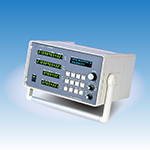| Simultaneous value, integration difference, velocity, and speed difference can be analyzed in 100 μs on the same time axis. | ||
 |
|
|
| This is a transmission deviation meter that inputs 2 channels of pulse signals such as A/B phase signals and UP/DOWN signals of a pulse output type incremental encoder and calculates the integrated value of each and the integrated difference between the two channels. The speed of ch A and ch B and the speed difference are also calculated at the same time. In addition to displaying the angle and rotation speed, the number of pulses and frequency can also be displayed. Since the analog output of the calculation is updated by 100 μs and 8 channels simultaneously, it is possible to analyze the integrated value, the difference in integration, the difference in speed, and the difference in speed on the same time axis. |
||
 |
 |
 |
| ■ 2ch simultaneous sampling Since the counters of CH A and CH B are read at the same time, the sampling time difference between the 2 channels is small, and the maximum is within 5 μs. ■High-speed arithmetic By adopting a ■ A/B phase signal max 1MHz input ■ Multi-form input signal support ■ Speed ratio setting Multiply the ■ 16-bit DA converter Uses 6 outputs of ■ Equipped with memory for logging |

